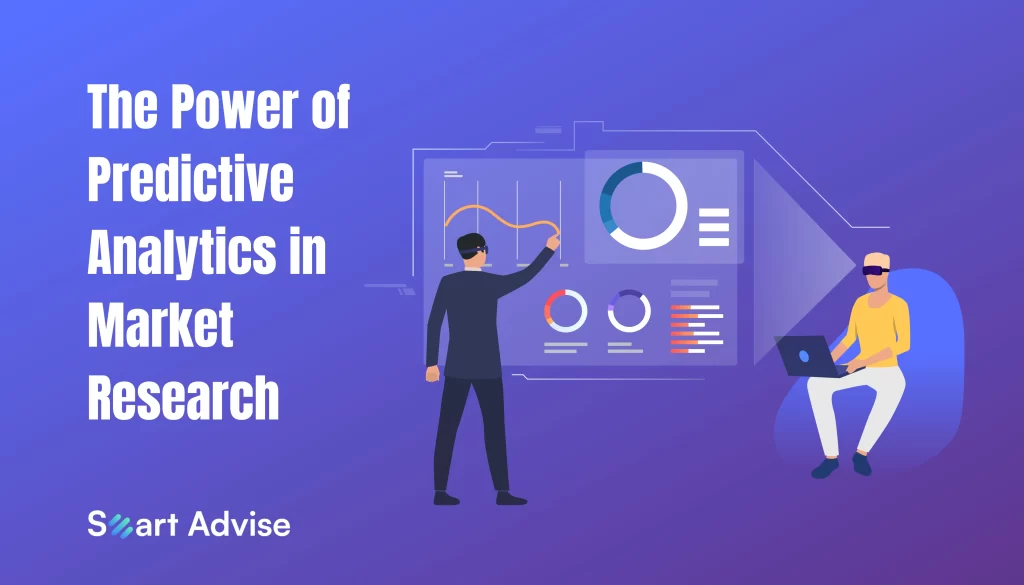
Businesses are dominating the market with Predictive Analytics. Find out how it helps your business stay ahead of the competition!
How can your business grow with calculative risks? Just market insights aren’t enough. What goes beyond insights is anticipation and prediction about the market, and that’s where the risk factor plays its role more efficiently with the help of predictive analytics
It enables organizations to uncover valuable deets, make accurate predictions, and drive strategic growth. In this article, we will explore what predictive analytics is, its significance in market research, and its transformative impact on businesses.
Understanding Predictive Analytics
Predictive analytics is a subfield of data analytics that seeks to predict future outcomes or patterns of behavior by employing such tools as statistical algorithms and machine learning. It goes beyond descriptive analytics, which focuses on understanding past events, to provide proactive insights and predictions for future actions. By analyzing historical data, identifying patterns, and building predictive models, organizations can gain a deeper understanding of customer behavior, market trends, and business performance.
The Role of Predictive Analytics in Market Research
In market research, predictive analytics plays a crucial role in providing actionable insights and driving data-based decision-making. It enables businesses to anticipate customer needs, identify emerging market trends, optimize marketing strategies, improve overall business performance, and achieve a sustainable competitive advantage.
Anticipating Customer Needs
Predictive analytics empowers businesses to understand customer behavior and preferences at a granular level. By analyzing past purchase history, browsing patterns, and demographic information, organizations can predict future buying behavior and tailor their offerings accordingly. For example, Amazon’s recommendation engine utilizes predictive analytics to suggest products based on a customer’s browsing and purchase history, leading to higher customer engagement and increased sales.
Identifying Emerging Market Trends
Businesses can use predictive analytics to spot and take advantage of new market trends. Organizations can detect fresh consumers’ desires, market trends, and rival plans by evaluating data from numerous sources, such as social media, online forums, and industry studies. This knowledge helps businesses make intelligent choices about developing new products, entering new markets, and making strategic investments.
According to Statista, in 2020, the market for predictive analytics software was valued at $5.29 billion, and it is projected to reach $41.52 billion by 2028.This growth is driven by the increasing adoption of predictive analytics across industries, including retail, finance, healthcare, and manufacturing.
Optimizing Marketing Strategies
As a result of predictive analytics, businesses can run more specific and effective ads than ever before. Organizations can foretell customer preferences, locate high-potential segments, and fine-tune marketing messages by evaluating customer data, such as demographic information, past interactions, and response patterns. As a result, your campaign will be more successful, your customers will be more engaged, and your return on investment will rise.
Improving Business Performance
Businesses can streamline their operations and improve their overall performance with the assistance of predictive analytics. Businesses are able to forecast demand, optimize pricing strategies, efficiently manage inventory, and improve supply chain operations when they leverage predictive models. As a consequence, this leads to cost reductions, improvements in operational efficiency, and a rise in profitability.
Enhancing Product Development
Predictive analytics aids in product development by providing insights into customer preferences, identifying market gaps, and predicting the success of new product launches. So, by analyzing customer feedback, market trends, and data on product performance, organizations can make data-driven decisions to optimize their product portfolio and improve innovation strategies.
Forecasting Sales and Demand
With the use of predictive analytics, organizations may make precise predictions about future demand and sales. Organizations can develop reliable sales projections by studying past sales data, seasonal trends, marketing initiatives, and external factors like economic indicators. As a result, this aids in meeting customer demand through optimized resource allocation, production planning, and inventory management.
Preventing Fraud and Mitigating Risks
To find any potential threat in the form of any fraud, analytics plays an important part. Companies can avert financial losses by being proactive in the face of possible fraud by examining trends and abnormalities in data. Creditworthiness and insurance claim fraud are two examples of risks that can be evaluated using predictive models to help firms make better decisions and reduce exposure.
Improving Customer Retention and Loyalty
Predictive analytics helps businesses identify factors influencing customer churn and develop strategies to improve customer retention and loyalty.
As Forbes quotes “Retaining existing customers is less expensive than acquiring new ones”
So, evaluating customer data, including behavior patterns, purchase history, and customer feedback, organizations can identify at-risk customers and implement targeted retention campaigns. This helps in reducing churn rates, increasing customer satisfaction, and fostering long-term customer loyalty.
Optimizing Pricing Strategies
To know where your product stands in the market, knowledge yourself of market conditions, competitor pricing, customer segmentation, and price elasticity, so that Price optimization can help businesses to threshold revenue.
With the help of predictive analytics, businesses can do so and can implement better price optimization strategies.
Streamlining Supply Chain Management
Predictive analytics helps optimize supply chain management by providing insights into demand fluctuations, inventory management, and logistics optimization. Through analyzing past sales information, supplier performance, and external factors such as weather and transportation, businesses can enhance supply chain efficiency, reduce costs, and minimize stockouts and excess inventory.
To conclude
Predictive analytics has emerged as a game-changer in market research, empowering businesses to make data-driven decisions, anticipate customer needs, and gain a competitive edge. With its ability to provide actionable insights, forecast future outcomes, and optimize various aspects of business operations, predictive analytics has become a crucial tool for organizations across industries.
The use of predictive analytics has helped businesses unlock new opportunities, enhance customer experiences, mitigate risks, and drive sustainable growth in today’s dynamic and data-rich business environment.
So, to assist you with this new predictive tool, Smart Advise is here to lend a helping hand. Connect with us to ensure not only predicting your growth but also making it a reality.